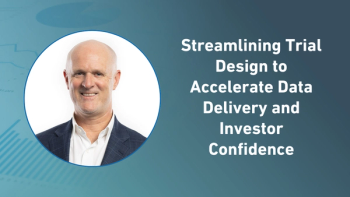
- Applied Clinical Trials-08-01-2013
- Volume 22
- Issue 8
Impact on the Future
The use of RBM may be the only way forward as long as the development of medicines relies on clinical testing.
Our industry is challenged to make drug development a more efficient process while delivering high quality results on time and within budget. The common knowledge in the industry is that clinical trials have become more complex and drug development costs continue to rise. However, the results and deliverables may not meet the levels of quality required for successful marketing applications. Put simply, the costs of failure are costing us all too much. The CRO industry as a whole must refine its services and deliverables and take the time to complete due diligence on the front end, in order to streamline the trial process and deliver projects as promised. As an industry, we have to increase our levels of strategic and tactical knowledge so that the insight we provide to our clients will ultimately deliver development programs of the highest caliber. Risk-based monitoring (RBM) is an approach that can actually save time and cost as it contributes to the efficient conduct of clinical trials.
Monitoring and its purpose
Sponsors of clinical trials must provide oversight to protect the rights, welfare, and safety of human subjects and the quality and integrity of data that are obtained during the trial.1, 2 With the technology and tools that have become available over the past 25 years, pharmaceutical development need not be bound to the same methods of monitoring that were being used in the 1980s. This is why the FDA and EMA are encouraging the use of modern methods for monitoring the progress, safety, and quality of clinical trials. In spite of encouragement from regulatory authorities, adoption of RBM and other innovative approaches has been slow. If we don't use them, we cannot benefit from them.
Risk-based monitoring—what is it?
Risk-based monitoring identifies the sources of risk that diminish the objectives of clinical development programs. Those objectives have already been stated: "protect the rights, welfare, and safety of human subjects and the quality and integrity of data." After these sources are identified, they are monitored during the course of a development program. This is where the "risk" aspect of RBM originates—risk is not part of RBM because less information is examined than would conventionally be examined and therefore it is "riskier" but costs less, so it is justified. Rather RBM carefully examines:
- What sources impose meaningful threats to the objectives of clinical development?
- What signals from those sources will be considered and how frequently they will be considered?
- What level of signal intensity from those sources will trigger an action, such as increased monitoring (on-site or remote) attention, or intervention and correction?
Risk-based monitoring may be difficult to understand because it regularly uses multiple methods to meet monitoring requirements that are present; it is not just one technique. The EMA noted,2 potential "adaptations to conventional GCP methods" when RBM is used. In doing so, the EMA suggests these might include adaptations to on-site monitoring visits, sample/focused/targeted source document verification, or centralized monitoring (both manual and electronic are possible). The various methods that can be employed may reduce the number of on-site visits required, however, crucially, this doesn't mean less information is being monitored. To obtain the expected benefits, the way in which the necessary information is monitored, compiled, analyzed, and interpreted must be better than conventional methods. Given the tools we have today, including major advancements in electronic data capture, we know that many of the associated tasks can be completed more frequently and at less cost through RBM than through conventional, on-site monitoring methods. Centralized monitoring can improve our ability to capture data anomalies, fraud, and safety concerns, and identify these threats more rapidly because of the whole-study or whole-program view, and because of the continuous, timely stream of data flowing into the centralized group. The fact that these broad issues can be detected and addressed throughout the course of a study means that the traditional end-of-study flurry of activity that can be so demanding and prone to error can be reduced in its magnitude. "Last minute" is no longer a required expectation.
Operational metrics can also be collected and interpreted by a centralized group. This characteristic enables the delivery of information to on-site monitoring personnel, resulting in more critical, productive, and efficient site visits.
[
Risk-based monitoring should not be considered a turn at the roulette wheel. It is not a throw of the dice, or even the development of computationally intense statistical algorithms aimed at establishing a sampling method, which itself reduces the amount of work required on a clinical study. RBM is instead a set of methods that, when applied throughout the planning and conduct phases, results in safer, less costly, and more successful studies; with the emphasis on higher quality.
How to achieve RBM effectively
Key aspects for the successful implementation of RBM include:
- Identification of variables related to program (or project) risks.
- Assessing those elements that impact regulatory compliance, protocol compliance, patient safety, and data integrity.
- Review data as they are collected, not waiting until the end of the program; this is especially critical for large studies with many patients involved.
- Anomalies in study characteristics trigger a site visit or other intervention.
Based on these requirements, effective integration and management of information is crucial to the successful implementation of RBM. This not only applies to hardware systems but also to software and people. It is essential to centralize and integrate disparate data sources so that the information they contain can be analyzed, interpreted, and acted upon. This is the focus of work currently underway at SynteractHCR. The Intelligent Clinical Development Plus (ICD+) platform of services and systems allows the compiling and use of the information necessary for conducting RBM on behalf of our customers.
To some extent, this goes against trends in our industry. It is common to fractionalize the people and information that are elements of a drug development program in order to obtain only a least cost solution. With this approach it is too hard to integrate all data and information across company lines when multiple vendors are involved. Instead, a platform where information is assembled and distributed to allow the opportunity to meet the objectives of the drug development programs is ideal.
The future of successful clinical monitoring depends on improving its efficiency and using it to reduce the amount of time that it takes to get new therapies to market. RBM offers a high quality approach that allows the streamlining of trials while providing a broad view of integrated data and resources. As long as new drug development relies on human clinical trials, RBM may be one of the best ways to reach those goals.
Philip E. Doren, PhD, is Vice President, Biometrics; Teri O'Donnell is Associate Director, Clinical Operations; and Jamie Pearson is Global Coordinator, Clinical Operations all at SynteractHCR, 5759 Fleet Street, Suite 100 Carlsbad, CA,
References
1. FDA, "Guidance for Industry Oversight of Clinical Investigations—A Risk-Based Approach to Monitoring," draft guidance,
2. EMA, "Reflection Paper on Risk Based Quality Management in Clinical Trials,"
Articles in this issue
about 12 years ago
Looking Further Into Transparencyabout 12 years ago
The Practical Implementation of Risk-Based Monitoringabout 12 years ago
Guidance and Strategies for Spurring Development of New Therapiesabout 12 years ago
RBM in Late Phaseabout 12 years ago
Paperless Clinical Trial Optimization—Thinking Outside the Boxabout 12 years ago
Controversy Grows Over How Best to Share Dataabout 12 years ago
SOPs in Clinical Researchabout 12 years ago
Comprehensive Evidence Development: Progress and Opportunitiesabout 12 years ago
Risk-Based Approachesabout 12 years ago
ACT Insert CoverNewsletter
Stay current in clinical research with Applied Clinical Trials, providing expert insights, regulatory updates, and practical strategies for successful clinical trial design and execution.






.png)



.png)



.png)
.png)
